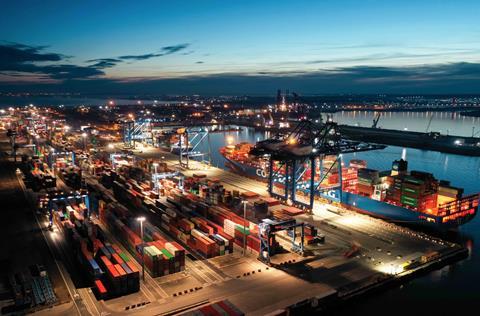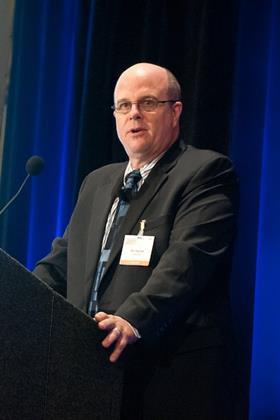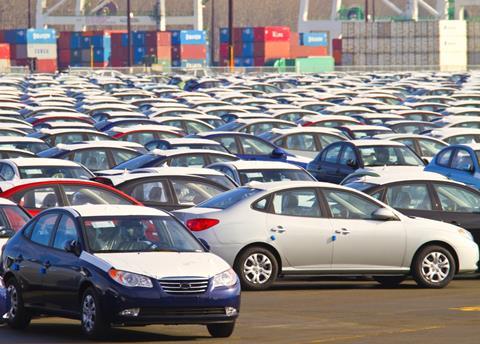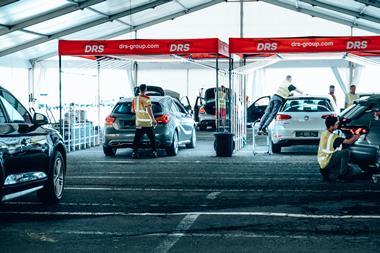Bill Garrett, head of the automotive vertical at DP World, talks to Automotive Logistics about the company’s transition to become a global provider of end-to-end logistics services for the automotive industry at a time of disruption and opportunity
Global logistics provider DP World is repositioning itself as a supplier of end-to-end logistics services for the automotive sector, rather than exclusively a leader in port operations, and it is targeting inbound and service parts logistics, as well as building on its established services in finished vehicle logistics. All three include new offerings for the movement of electric vehicles and their lithium batteries, a growing area of business for its customers and their suppliers requiring specialist logistics services.

Bill Garrett, head of the automotive vertical at DP World, was born in Detroit and has 30 years of experience in automotive logistics, both in operations and commercial roles. Here he talks to Automotive Logistics about the company’s mission to become a global provider of services for the sector and setting the right expectations as trends in car manufacturing and supplier contracts change.
Automotive Logistics: DP World is fundamentally changing its service offering for the automotive industry at a time when that industry is itself in transition. What are you doing to keep pace?
Bill Garrett: We have a mission to be an end-to-end provider of services and we are targeting attractive businesses in that space. We are also in acquisition mode to fill in any gaps in the supply chain so we have a comprehensive solution.
Accepting that the car companies don’t usually purchase in that way, we have some work to do in helping them understand the value and we are working in that direction.
We have seven regions around the globe. The bulk of our automotive business sits in Europe and North America. We made a couple of big acquisitions over the last few years, with Syncreon and Imperial for example, designed to bolster our automotive capabilities.
DP World has a long history serving the automotive industry with ro-ro port services. We have handled millions of cars. Now the idea is to dig into the supply chains of these carmakers rather than just being a port provider.
Can you talk about some of the new services that DP World is now offering beyond vehicle ro-ro at the ports?
On inbound to assembly we have extensive operations, lineside, metring and sequencing, and we do that for a number of OEMs in North America and Europe.

For service parts, that is a piece that we are building. We have a few operations in place today and we are ramping that up. We are going to grow that organically through acquisition in pursuit of where we need to go.
The battery warehouse is on that side of the business. We have a couple of those in place in Europe already and we are moving forward with that rapidly.
On the finished vehicle supply chain, we move a lot of cars already but there is a huge ro-ro capacity issue affecting global shipments today, so the car companies are scrambling to move cars where they need to go, especially on the international side. We are seeing volumes they want to move in containers that we have not seen before. There are staggering amounts of cars out there, with hotspots in China and Mexico.
In October we bought CFR Rinkens, a provider of vehicle containerisation services, and we are ramping that business up and integrating that into DP World as we speak.

Our big thing right now is setting the right expectations with the customer because there is so much out there and it is impossible for providers to do it all. No one has enough capacity in terms of racks and containers to handle it all, so we are taking care of our key customers as best we can with all of that.
Container movements are currently being disrupted by the action taken by Houthi militants on shipping in the Red Sea. How is this situation and others affecting global shipping impacting DP World’s services?
It is a huge issue and one of our big challenges is setting the expectations and making sure we can handle what we are taking on. The volumes we are seeing are huge. For instance, we are talking about moving 50,000 cars out of China down to South America. It’s a lot for a container service. That is a six-month project to get all the racks sitting there and everything ready to go. It can take 3-5 months at least to get that sort of volume moved. It is a challenge for everybody.
In addition, since the Covid pandemic there has been a shakeup of the whole global supply chain for automotive. We are seeing more near-shoring, we are seeing the diversification of suppliers and we have to be in place for them. As these car companies expand out globally into new and different markets, we want DP World to be there. We are virtually capable of operating in every country and we want to follow our customers into the new markets and regions they are moving into.
Does that include Chinese manufacturers, given the current increase in vehicle exports from China to global markets?
In terms of exports out of China there are going to be 50,000 cars exported a month. That is where we need to be playing in a big way. We see ourselves taking the cars where they need to go and follow that up with parts logistics. The automotive business in China today is something we need to be a big part of and we are going to integrate that with the other regions. We will take our core capabilities from North America and Europe and import those into China and other regions so we can provide the same level of service and capabilities around the globe.
DP World recently supported the Trade in Transition report from Economic Impact, which looks at the management of risk and the attempts OEMs are making to build in resilience to the supply chain, either through supplier diversification or tighter consolidation. What is DP World doing in pursuing a strategy of resilience.
The Trade and Transition study shows that there is a smaller supplier base in some cases, while in others companies are dual sourcing. We have got to be able to adapt to those changes [in either case]. We have a lot in place but we continue to build those capabilities to satisfy that customer need.
READ MORE ABOUT THE TRADE IN TRANSITION PAPER FROM ECONOMIC IMPACT
It also depends on which OEM you are talking about. Some of them are going in the direction of multiple-source points for the same part or assembly product, while others go for the longer-term contract with a single supplier. A lot of that is to do with where that supplier is located and what the transit time is. If you have a Chinese supplier feeding into North America you are going to want a contingency plan with another supplier. If they are feeding a US plant locally I think it is a different story. There is more in the mix than one supplier or two suppliers. It’s geographic and whether an OEM is comfortable that the supplier can produce the volume needed and be consistent. And then there is the international complexity of supply chain and the timeframe involved there.

The other factor in there is the cost of the goods. If it is a very expensive product you don’t want to have a long transit time. You are going to put it closer to home and source it near where you are at. We are seeing a mix across car companies of how this is being handled today. It is not one size fits all.
In terms of delivering things over a longer distance the rise in oil prices has an impact on transport costs.
What we see with the suppliers that are a long distance away is a bigger safety stock. We are seeing people hold more material, with more material in transit as you might expect to cushion that supply chain and ensure there are no disruptions. With suppliers that are closer they are coming in with what they need that day or the next day.
What about other services DP World is offering that give it a competitive advantage?
We have some capabilities at DP World that others potentially do not have that we can compete with. Trade financing is one example. We trade finance for inventory and material that is in transit. We want to take that trade finance and pair it up with the finished vehicle transit and potentially trade finance those vehicles while they are in transit, either by ro-ro or container. Even if that is a 20-30 day transit time, freeing up that capital for those OEMs is a big deal for them. We are pitching that to the Chinese manufacturers and to the European ones, and that is a value add that we can bring to the vehicle supply chain that few others in the business can do. It is a big plus for us.


























![Global[1]](https://d3n5uof8vony13.cloudfront.net/Pictures/web/a/d/s/global1_726550.svgz)













No comments yet